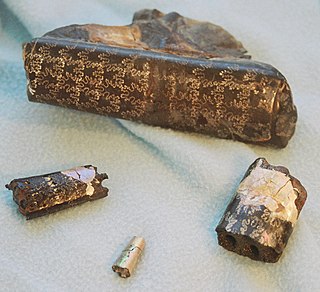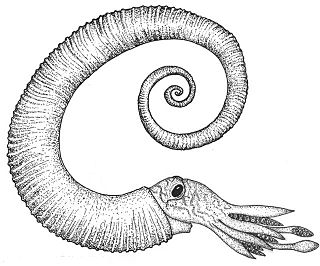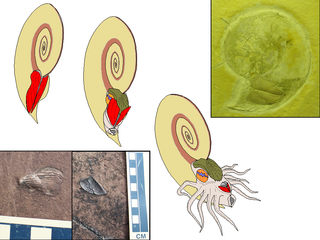
Ammon was an ancient Semitic-speaking kingdom occupying the east of the Jordan River, between the torrent valleys of Arnon and Jabbok, in present-day Jordan. The chief city of the country was Rabbah or Rabbat Ammon, site of the modern city of Amman, Jordan's capital. Milcom and Molech are named in the Hebrew Bible as the gods of Ammon. The people of this kingdom are called Children of Ammon or Ammonites.

Ammonoids are extinct spiral shelled cephalopods comprising the subclass Ammonoidea. They are more closely related to living coleoids than they are to shelled nautiloids. The earliest ammonoids appeared during the Devonian, with the last species vanishing during or soon after the Cretaceous–Paleogene extinction event. They are often called ammonites, which is most frequently used for members of the order Ammonitida, the only remaining group of ammonoids from the Jurassic up until their extinction.

Ammonite is the extinct Canaanite language of the Ammonite people mentioned in the Bible, who used to live in modern-day Jordan, and after whom its capital Amman is named. Only fragments of their language survive—chiefly the 9th century BC Amman Citadel Inscription, the 7th–6th century BC Tel Siran bronze bottle, and a few ostraca. As far as can be determined from the small corpus, it was extremely similar to Biblical Hebrew, with some possible Aramaic influence including the use of the verb ‘bd (עבד) instead of the more common Biblical Hebrew ‘śh (עשה) for 'make'. The only other notable difference with Biblical Hebrew is the sporadic retention of feminine singular -t Ammonite also appears to have possessed largely typical correspondences of diphthongs, with words such as ywmt both preserving and showing a shift to, and other words such as yn exhibiting a shift of to ē much like Hebrew.

The Barremian is an age in the geologic timescale between 125.77 Ma and 121.4 ± 1.0 Ma It is a subdivision of the Early Cretaceous Epoch. It is preceded by the Hauterivian and followed by the Aptian Stage.

Goniatids, informally goniatites, are ammonoid cephalopods that form the order Goniatitida, derived from the more primitive Agoniatitida during the Middle Devonian some 390 million years ago. Goniatites (goniatitids) survived the Late Devonian extinction to flourish during the Carboniferous and Permian only to become extinct at the end of the Permian some 139 million years later.

Baculites is an extinct genus of heteromorph ammonite cephalopods with almost straight shells. The genus, which lived worldwide throughout most of the Late Cretaceous, and which briefly survived the K-Pg mass extinction event, was named by Lamarck in 1799.

The Ancyloceratina were a diverse suborder of ammonite most closely related to the ammonites of order Lytoceratina. They evolved during the Late Jurassic but were not very common until the Cretaceous period, when they rapidly diversified and became one of the most distinctive components of Cretaceous marine faunas. They have been recorded from every continent and many are used as zonal or index fossils. The most distinctive feature of the majority of the Ancyloceratina is the tendency for most of them to have shells that are not regular spirals like most other ammonites. These irregularly-coiled ammonites are called heteromorph ammonites, in contrast to regularly coiled ammonites, which are called homomorph ammonites.

The Early Jurassic Epoch is the earliest of three epochs of the Jurassic Period. The Early Jurassic starts immediately after the Triassic–Jurassic extinction event, 201.3 Ma, and ends at the start of the Middle Jurassic 174.7 ±0.8 Ma.

An aptychus is a type of marine fossil. It is a hard anatomical structure, a sort of curved shelly plate, now understood to be part of the body of an ammonite. Paired aptychi have, on rare occasions, been found at or within the aperture of ammonite shells. The aptychus was usually composed of calcite, whereas the ammonite shell was aragonite.

Ammonitida or "True ammonites" are an order of ammonoid cephalopods that lived from the Jurassic through Paleocene time periods, commonly with intricate ammonitic sutures.

The body whorl is part of the morphology of the shell in those gastropod mollusks that possess a coiled shell. The term is also sometimes used in a similar way to describe the shell of a cephalopod mollusk.
The Toarcian is, in the ICS' geologic timescale, an age and stage in the Early or Lower Jurassic. It spans the time between 184.2 Ma and 174.7 ±0.8 Ma. It follows the Pliensbachian and is followed by the Aalenian.
In the geologic timescale, the Valanginian is an age or stage of the Early or Lower Cretaceous. It spans between 139.8 ± 3.0 Ma and 132.6 ± 2.0 Ma. The Valanginian Stage succeeds the Berriasian Stage of the Lower Cretaceous and precedes the Hauterivian Stage of the Lower Cretaceous.
The Campanian is the fifth of six ages of the Late Cretaceous Epoch on the geologic timescale of the International Commission on Stratigraphy (ICS). In chronostratigraphy, it is the fifth of six stages in the Upper Cretaceous Series. Campanian spans the time from 83.6 to 72.1 million years ago. It is preceded by the Santonian and it is followed by the Maastrichtian.
The Hauterivian is, in the geologic timescale, an age in the Early Cretaceous Epoch or a stage in the Lower Cretaceous Series. It spans the time between 132.6 ± 2 Ma and 125.77. The Hauterivian is preceded by the Valanginian and succeeded by the Barremian.
The Hettangian is the earliest age and lowest stage of the Jurassic Period of the geologic timescale. It spans the time between 201.3 ± 0.2 Ma and 199.3 ± 0.3 Ma. The Hettangian follows the Rhaetian and is followed by the Sinemurian.
In the geologic timescale, the Kimmeridgian is an age in the Late Jurassic Epoch and a stage in the Upper Jurassic Series. It spans the time between 154.8 ±0.8 Ma and 149.2 ±0.7 Ma. The Kimmeridgian follows the Oxfordian and precedes the Tithonian.

The Ammonite order is an architectural order that features fluted columns and capitals with volutes shaped to resemble fossil ammonites. The style was invented by George Dance and first used on John Boydell's Shakespeare Gallery in Pall Mall, London in 1789.

Cephalopod egg fossils are the fossilized remains of eggs laid by cephalopods. The fossil record of cephalopod eggs is scant since their soft, gelatinous eggs decompose quickly and have little chance to fossilize. Eggs laid by ammonoids are the best known and only a few putative examples of these have been discovered. The best preserved of these were discovered in the Jurassic Kimmeridge Clay of England. Currently no belemnoid egg fossils have ever been discovered although this may be because scientists have not properly searched for them rather than an actual absence from the fossil record.

Ammonite is a 2020 romantic drama film written and directed by Francis Lee. Loosely inspired by the life of British palaeontologist Mary Anning, played by Kate Winslet, the film centres on a speculative romantic relationship between Anning and geologist Charlotte Murchison, played by Saoirse Ronan. Gemma Jones, James McArdle, Alec Secăreanu and Fiona Shaw also star.













